Which file type is the best choice for digital camera captures? Both RAW and JPEG have distinct advantages. Take a closer look in the article below before you set up for your next shoot.
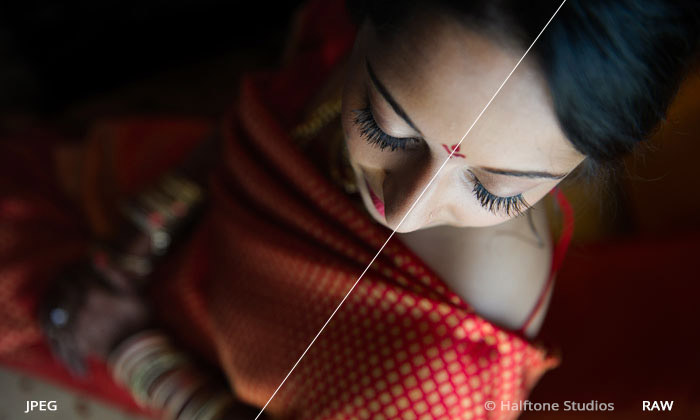
The images in this article were captured as both RAW and JPEG files before any editing adjustments were made. Image type is a decision made in-camera. The default could be either type (it varies by camera).
What is RAW?
RAW files are uncompressed and unprocessed captures of all the detail your digital camera sensor is capable of recording. In its purest form, it’s the raw sensor data. The term ‘digital negative’ expresses the idea of exposed analog film in a digital environment. However you refer to it, RAW is the superior file format when it comes to post-processing. This is especially true when you compare RAW and JPEG files.
Why is RAW important?
You get the highest possible quality and the most data. RAW has more zeros and ones per file than any other image type. This becomes important when you’re editing and printing. The more info the computer has to work with, the more you are able to tweak without degrading your image. This becomes especially important when working with shadows or highlights. With a RAW file, you can recover this information through edits.
With a JPEG file, some image information might not be written to your card. This is because JPEG is a lossy format, which means that, in order to reduce image size, data is compressed and “unimportant” information is discarded. Depending on the kinds of edits you want to make in your image, this discarded information could turn out to be important.
With JPEGs, the camera locks in all the settings that applied when the shot was taken. With a RAW file, you can adjust these settings (exposure, white balance, color, contrast, highlighting, etc.) in post.
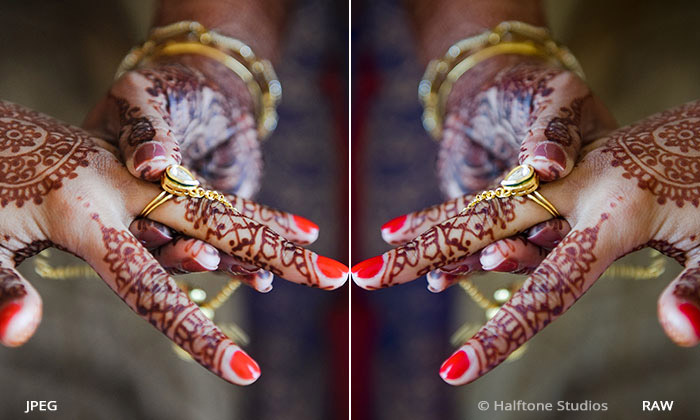
Look at the color depth in this comparison between RAW vs JPEG formats. The rendered color is noticeably different between the two frames. The RAW format does a better job capturing the skin, which appears much more flat in the JPEG. The bold red nail polish is richer in the RAW file.
What does RAW vs JPEG do for you?
Let’s consider brightness, which is measured in levels. A JPEG captures 8 bits, while RAW files capture 12 bits or more. Bits equate to levels of brightness. An 8-bit files give you 256 levels, or slices of information, per file. This means that each pixel has 256 notches between solid white and black (or of red, green, and blue). A 14-bit RAW file can have more than 16,000 levels. So, thinking in the tiny aggregate of a RAW image, transitions between tones in the shot will be smoother. And the image will hold up to more adjustments in post processing. So you can recover the face of someone in the background of the shot without them looking like a grainy mess. So when comparing RAW vs JPEG, RAW definitely contains more information, which gives the editing pipeline more data to work with.
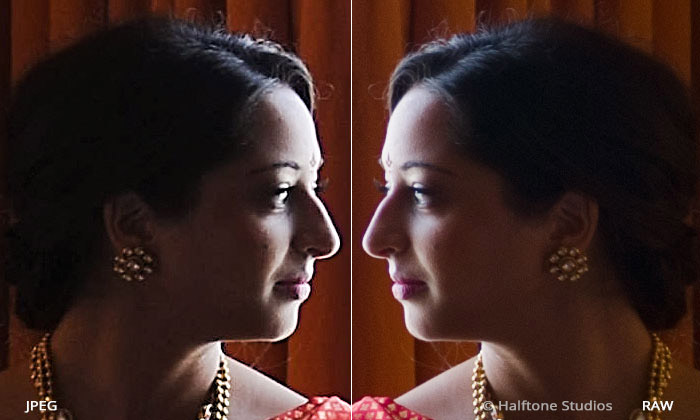
This image directly compares RAW vs JPEG files. The differences between these two formats really comes out when the images are heavily edited. These two were treated with an identical preset in Exposure X2, Kodachrome 64 (sharp). Note the abundance of sharpening artifacts on the JPEG image.
JPEGs aren’t all bad
Lossy format images like JPEGs have some merits of their own. They are significantly smaller. This means you can fit more on your card, and that they won’t take up so much hard drive space. Processing these images is quicker because there is less information for your computer to deal with. So if you’re only editing pics with friends or family for Instagram, RAW could be overkill.
When photographing rapid motion, such as children playing, wildlife, or sports events, using JPEGs is often a wiser choice. If the scene is lit properly, you’ll have a better chance of capturing the perfect moment, since your camera can rapid fire these smaller JPEG images. On a high-quality camera, the visual quality will be still very good. Shooting RAW on the other hand will likely choke up the image buffer after a burst of shots, making you unable to shoot at all until the camera writes the images to the card.
JPEGs are already processed, so what you see is what you get. The camera has locked in all the settings that applied when the shot was taken. This is the instant film version in the digital world.
RAWs are commonly recorded in a proprietary format, meaning that you need specialized software to view the file. If you use Exposure, this isn’t an issue, since Exposure supports a wide variety of RAW image types. Exposure users also have the benefit of Exposure’s speed. If you have your RAW files saved to a fast internal drive, then Exposure is able to quickly load even large ones.
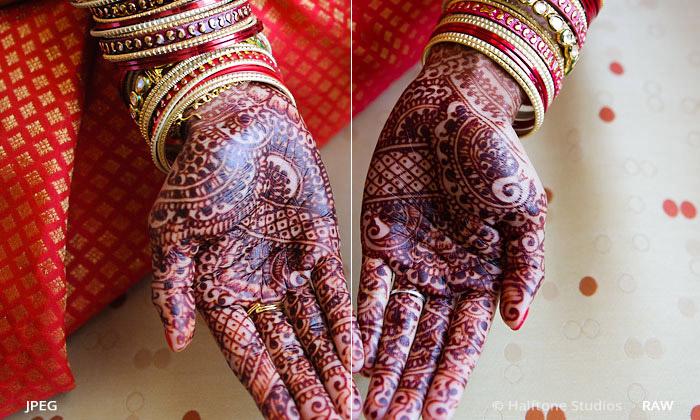
Look for optimal lighting conditions when shooting JPEGs, which will minimize the chance of visible artifacts showing up. Exposure’s Kodachrome 64 preset adds a touch of golden brown tone to this shot.
Consensus
RAWs store more information, but are also more demanding than JPEGs in terms of shooting speed, storage space, and processing power. Most professionals and even many hobbyists depend on RAW for the freedom that it provides them when editing. JPEGs however have their place, especially if you need to shoot many images quickly.
Try Exposure Today












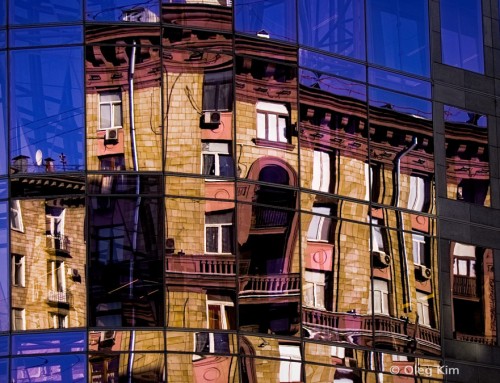
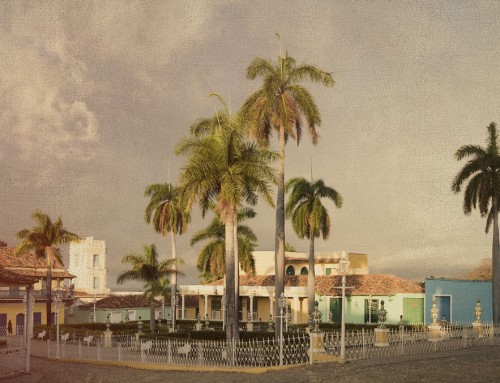
Another issue with jpeg files is the continual loss of data every time the file is opened and saved. The compression algorithm re compresses the data with each save and more “unimportant” data is eliminated.
Hi Kevin,
Yes, that’s an issue as well. Luckily when Exposure is used as a standalone, the editing workflow is nondestructive. Edits saved as sidecar files keep file degradation from happening.
Great article Jimmy.
Thanks, Tony!
Another option is shooting in both JPEG and RAW simultaneously. Of course this only exacerbates the issues you already addressed concerning raw, however there may be some advantages to doing so for our New To Photography friends and Working Pro’s. How so? After the excitement of getting that new camera on Christmas morning and the new photographer starts looking at their captures, editing raw files is initially a more complex process than just opening a jpeg and doing some quick levels / layers / healing brush (et al) then posting online or sending servicable images to Famly & Friends. To most eyes, that new DSLR set on auto mode can capture surpringly good images after even a few modest skills are grasped. And as that New Photographers eye improves, a yearning comes about for better image creation and more gear! However, as they learn raw workflows, initially the JPEG gives them the visual (and familiar) idea of what the image sorta looked like when she released the shutter two weeks ago at Aunt Bertha’s birthday party. She can begin the raw processing with an end in mind.
The working pro can simplify her workflow post shot by using properly exposed/composed jpegs as quick outtakes to send clients to whet their appetite or make sure that the creative direction is correct. I’ve even experienced odd instances when I was able to produce a better image in post with a jpeg than a raw file (very rarely but it happens).
Fast cards, fast os read/write speeds and big buffers are KING!!
I mainly photograph Indian weddings, shooting in varying lighting conditions just as most wedding photographers have to do. In my opinion RAW is the only option.
As you correctly point out the colours just jump out at you and also there is a leeway for not nailing the exposure for every image. Get your workflow correct and it doesn’t take too long to process the images.